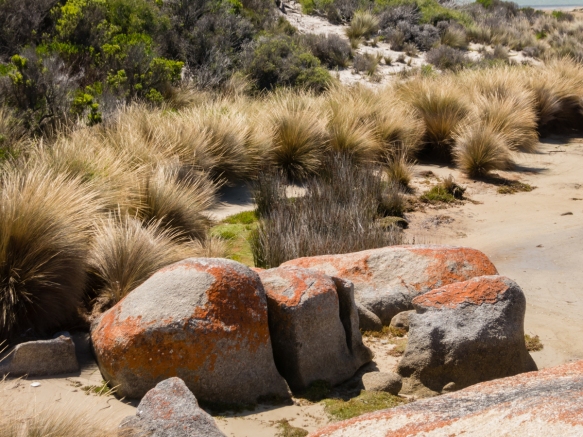
Cattle grazing on the southern end of Flinders Island, overlooking Strzelecki National Park, Tasmania, Australia
“Flinders Island is one of more than 60 islands, in the Furneaux Group which is located between Wilson’s Promontory, Victoria and Cape Portland, Tasmania [Australia]. Flinders Island is the largest of these islands and the region has around 900 permanent residents. Flinders is a long, narrow island, 75 km long and 40 km wide, with the Darling Ranges running along the middle of the island. The Furneaux Group of islands is what remains of the original land bridge that once joined Tasmania to mainland Australia. The time of the flooding of this land bridge is a contentious point for many scientists but it is believed to have happened between 12,000 and 18,000 years ago. Over these thousands of years, water erosion has formed some of the most spectacular rock formations and scenery you will find anywhere in the world. The islands lie scattered around latitude 400 south and are home to a very diverse wildlife with over 120 species of bird are found on Flinders Island including many visiting migratory, Northern Hemisphere species. The region is also home to the rare Cape Barren Goose and the endangered 40-Spotted Pardalote. Flinders Island has a thriving rural community that produces sheep and wool, cattle, milk-fed lambs, crayfish, abalone, wine and wallaby. Other main business activities include rural support industries and tourism.” – visitflindersisland.com.au

We walked the length of Yellow Beach from its entrance at the lovely town of Lady Barron, Flinders Island, Tasmania, Australia, and on to the rock formations separating it from White Beach, on the southeast corner of the island

Rock formations separating Yellow Beach from White Beach, on the southeast corner of the island, near Lady Barron, Flinders Island, Tasmania, Australia

The grass clumps made an interesting contrast with the rocks on the shore of White Beach, Flinders Island, Tasmania, Austra

Looking south to Franklin Sound and Cape Barren Island from White Beach on Flinders Island, Tasmania, Australia
We enjoyed an excellent luncheon of local Tasmanian cuisine at the small Shearwater Restaurant in Furneaux Tavern in the charming town of Lady Barron after our hike along Yellow Beach and White Beach. One of our main dishes was beautifully prepared wallaby – it tasted a lot like a cross between been and pork, and was delicious.

One of the four quadrant views from Walker’s Lookout on Mt. Leventhorp, the highest point on Flinders Island, Tasmania, Australia
“ABORIGINAL AND EUROPEAN HISTORY: When the Eastern Bass Strait islands were still a land bridge between mainland Australia and Tasmania the region was a highway for travelling aboriginal groups. With the flooding of the land bridge the Tasmanian aboriginal community was separated from their mainland cousins and they developed their own culture and practices. The history of Flinders Island begins with the Tasmanian Aboriginal people who were the first residents 35,000 or more years ago. About 4,000 to 9,000 years ago for reasons uncertain the Tasmanian Aboriginals ceased to be full time occupants of the Furneaux group of which Flinders is the largest island. The next human contact was when Tobias Furneaux discovered the islands in 1773. However, he did not land on any of the islands. In 1797 the merchant vessel “Sydney Cove”, en route from Calcutta to the fledgling colony at Port Jackson, was beached off Preservation Island (south of Cape Barren Island) this saw the discovery of large quantities of seals and the start of wholesale sealing in the region. Thus began the first export industry for Australia namely sealskins and oil and the first European settlement, of sealers, south of Sydney at Kent Bay (southern coast of Cape Barren Island). By 1810 the sealing industry had passed its peak. Some of the sealing fraternity remained on the smallers Furneaux islands and took aboriginal women as their partners and these men became known as the Straitsman.
“Meanwhile from 1803 onwards Tasmanian Aboriginals living on mainland Tasmania (Van Diemen’s Land as it was called then) experienced considerable harassment from the white settlers as these Europeans steadily pushed into aboriginal lands. Understandably there was retaliation by the aboriginal people. Later this period was referred to as the Black War. In 1830, Governor Arthur, with the help of George Augustus Robinson attempted to ensure the survival of the aboriginal people by exiling them to the Furneaux Islands. Eventually by 1833 after first trying Swan Island, then Gun Carriage island (now called Vansittart) and then the Lagoons at the southern end of Flinders, this place of exile was Wybalenna, meaning Blackman’s Houses, on Flinders Island. This settlement was far from successful. Of the 200 odd aboriginal persons that lived at Wybalenna over 150 died due to exposure to dieases like influenza and pneumonia to which they had no natural defence, to heartbreak and being forced to live an alien lifestyle. They are buried in the Wybalenna cemetery. In 1847 the remaining Aboriginal people were transported back to Tasmania to Oyster Cove where one by one they died. Even so the Tasmanian Aboriginal people, many with Straitsman ancestors, live on and much of their culture survives. Over 16% of the population of Flinders is Tasmanian Aboriginal. The restored Chapel is the only building remaining from the ill fated Wybalenna settlement.” — visitflindersisland.com.au

The historical chapel at Wybalenna settlement near the town of Emita on the west coast of Flinders Island, Tasmania, Australia

A good explanation of why the rear door of the Wybalenna settlement chapel was locked, Flinders Island, Tasmania, Australia

Our ship anchored at Trousers Point Beach, Flinders Island, Tasmania
